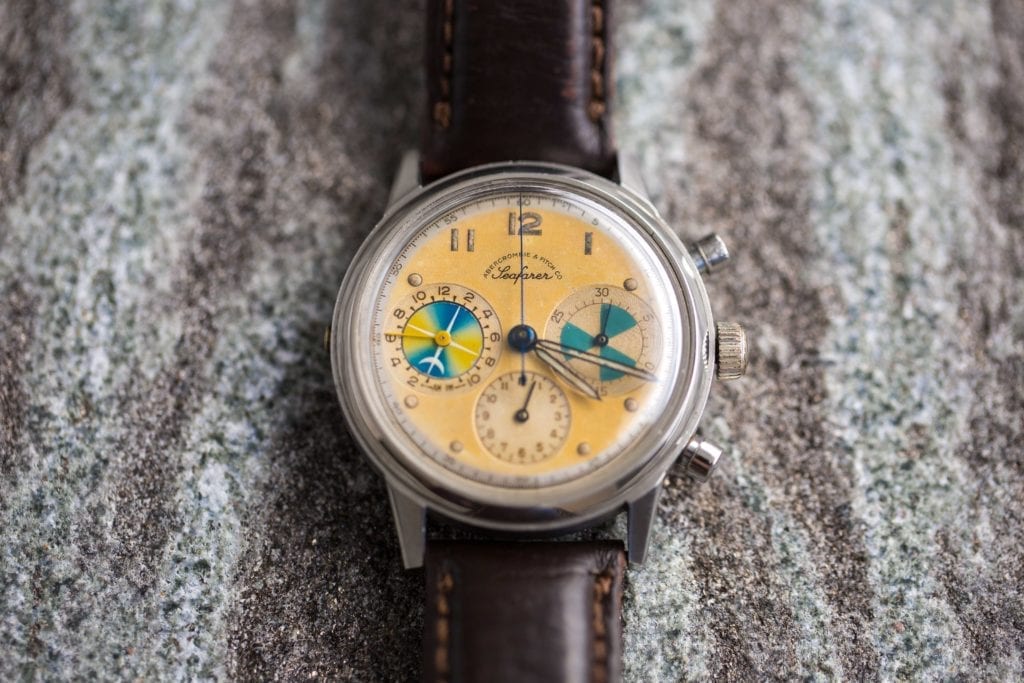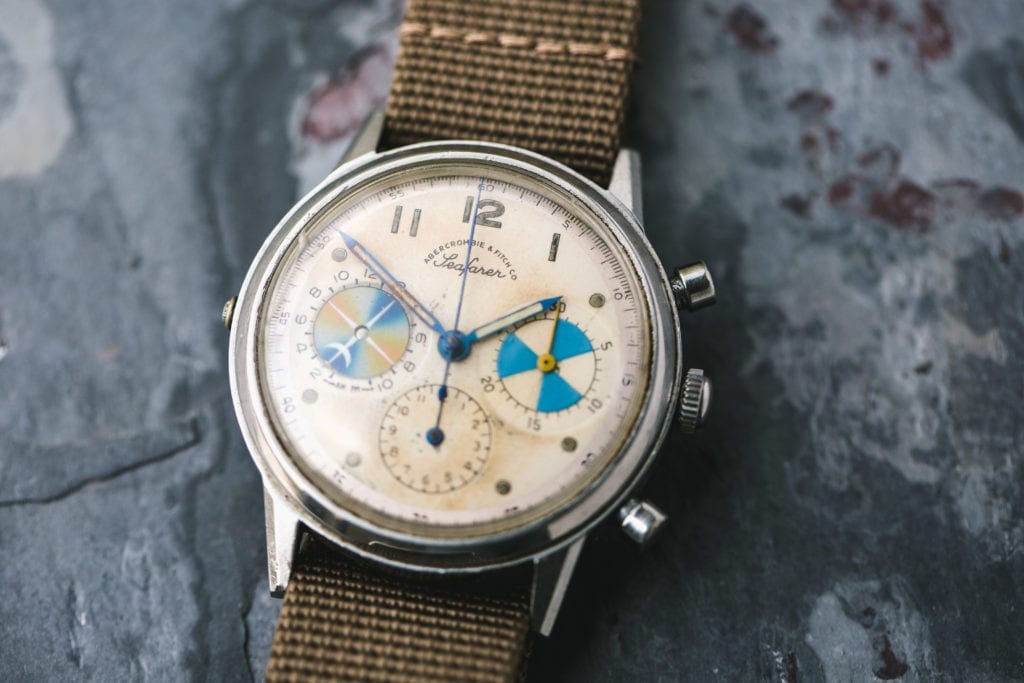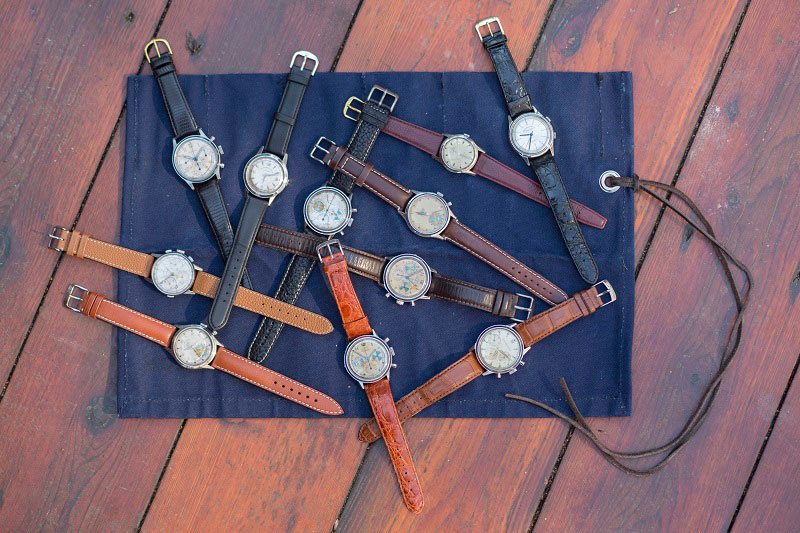Jeff Stein is the nation’s foremost Heuer expert, founder of On The Dash, and a good friend of Crown & Caliber’s. Jeff recently stopped by the Crown & Caliber offices for a bit of show and tell with some of his favorite watches, his collection of Abercrombie & Fitch watches. We also had several Abercrombie watches in our inventory, so we decided to put them all together for a photoshoot. This collection includes a couple of Seafarer, Solunar, Auto-Mark, and Auto-Graph watches.
We decided to take advantage of this opportunity and dive into the interesting history of the Abercrombie & Fitch watch brand and how it has evolved over time. This write-up explores the brand’s history and gives watch enthusiasts a look inside the collection of Heuer expert, Jeff Stein. After learning more about the brand, it will become evident as to why Abercrombie & Fitch watches appeal to vintage watch collectors, such as Stein.
The History of Abercrombie & Fitch Watches

Abercrombie & Fitch of old is very different from the Abercrombie & Fitch of today. The company was founded in 1892 and had two locations, one in Chicago and one in New York. It produced top-quality gear for numerous outdoor sports, such as fishing, racing, hunting, and many others. It’s advertisements promoted itself as the sporting goods store of choice for any true explorer or outdoors-man. From hunting gear to gadgets to hot air balloons, Abercrombie & Fitch carried everything that any sportsman would ever need. In the 1940s, Heuer began producing chronograph watches for the brand. Heuer was known for it’s dashboard timers and its relationship with the racing community. These new Heuer chronograph watches for Abercrombie & Fitch became some of the most popular and useful tool watches, as fishermen and racers were actually using these watches to help them in their sport. According to Stein, “This is where the proper people went to be outfitted if they were going on an expedition, if they were going on a vacation, if they were going motoring. So Abercrombie & Fitch was a destination.”
Below, we explore some of the most popular Abercrombie & Fitch watch models and show off some of the watches in Jeff Stein’s collection.
Abercrombie & Fitch Auto-Mark Watch
The Abercrombie & Fitch Auto-Mark watch was marketed in the 1950s as “The Sportman’s own Timer-Watch.” The automatic wrist watch can easily convert into a precision timer for any sporting event. It can time to 1/5th of a second in a race, has a calibrated mph dial, and has a 12-hour recording timer. It could also easily translate into an every day watch with business or casual wear.
Abercrombie & Fitch Auto-Graph Watch
In 1948, Abercrombie & Fitch introduced the Auto-Graph watch. The distinguishing features of this watch model was its tachometer scale and its manual reference hand. The main function of the Abercrombie & Fitch Auto-Graph watch was to measure the speed of an automobile over a measured mile. It has a 1/5th second stopwatch and can measure speed runs over a mile from 41 to 120 mph. It also has the ability to time long-distance phone calls with special calibrations on its dial. Its three dials work together to record a day’s run, up to 12 hours. Advertisements from the 1940s and 1950s advertised the watch as the ideal watch for racers.
Abercrombie & Fitch Solunar Watch
In the late 1940s, Abercrombie & Fitch set out to enhance hunting and fishing for avid outdoorsmen by providing them with the ultimate tool that could fit on their wrist. With Heuer as a partner in their endeavor, Abercrombie & Fitch released the Solunar Watch. The watch is based on the solunar theory, which proposes that the positions of the sun and moon help indicate the times for optimal hunting and fishing. The Solunar watch is outfitted with a 44mm stainless steel case, manual wind movement, and a colorful solunar subdial featured at 6 o’clock.
Abercrombie & Fitch Seafarer Watch
Although the Solunar watch provided an unparalleled technology at the time, many outdoorsmen were reluctant to use the tool in lieu of traditional of maps and charts. Instead of accepting defeat, Abercrombie & Fitch intended to make a more useful version of the Solunar Watch. Thus, a few years later, the Abercrombie & Fitch Seafarer was born. A superior successor to the Solunar watch, the Seafarer combines the solunar display with a three-register chronograph, giving it far more functionality than its predecessor.

The Seafarer was first run by the Valjoux 71 movement in the earliest 346 model, and in later models by Valjoux 72, both complex movements developed by Heuer. There are six different models and numerous different phases of the Seafarer, each with a slight variation from the last. However, all Seafarer models possess distinctive dials displaying vibrant colors and unique functions through the solunar dial (at nine o’clock) and minute recorder (at three o’clock).
Now an outdated technology, both the Solunar and Seafarer are sought after today primarily for their striking vintage look and rarity. While some models are more commonly found selling today than others, any Seafarer in excellent condition is an exceptional find. The Seafarer is a conversation-starting piece and is the perfect vintage addition to any watch collection.
While today’s Abercrombie & Fitch stores are very different from the stores in the 1940s and 1950s, the rare Abercrombie & Fitch watch models are still highly respected and coveted pieces in the watch industry. Thanks to Jeff Stein for sharing his Abercrombie & Fitch watch collection with us.
Get More Articles Like This in Your Inbox
We're constantly creating great content like this. So, why not get it delivered directly to your inbox? By subscribing you agree to our Privacy Policy but you can unsubscribe at any time.







Phil | January 14, 2020
|
Definitely missing the heuer Shipmate abercrombie and fitch. One with the original link band sold for 4,000. These are beComing very popular among collectors!